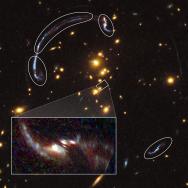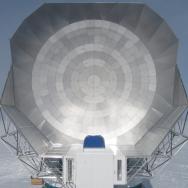Astronomers at the University of Chicago, MIT and elsewhere have used a massive cluster of galaxies as an X-ray magnifying glass to peer back in time, to nearly 9.4 billion years ago. In the process, they spotted a tiny dwarf galaxy in its very first, high-energy stages of star formation.
While this technique has been used to magnify objects at optical wavelengths, this is the first time scientists have leveraged it to zoom in on extreme, distant X-ray-emitting phenomena.
What they detected appears to be a blue speck of an infant galaxy, about 1/10,000 the size of our Milky Way, in the midst of churning out its first stars—supermassive, cosmically short-lived objects that emit high-energy X-rays, which appear at optical wavelengths in the form of a faint blue arc.
“It’s this little blue smudge, meaning it’s a very small galaxy that contains a lot of super-hot, very massive young stars that formed recently,” said Matthew Bayliss, a UChicago alum who is currently a research scientist in MIT’s Kavli Institute for Astrophysics and Space Research. “This galaxy is similar to the very first galaxies that formed in the universe...the kind of which no one has ever seen in X-ray in the distant universe before.”
This is because it’s an extraordinarily difficult task, said Prof. Michael Gladders of the University of Chicago, a co-author on the paper and Bayliss‘ former PhD adviser.
“The universe is full of things that emit X-rays, and up until now, being able to pick out something like this has been completely out of reach of today’s telescopes,” said Gladders, a leading expert in the field of gravitational lensing. “This is a glimpse of what we’ll be able to see routinely with the next generation of telescopes.”
Bayliss, MSc’07, PhD’11, said the detection of this single distant galaxy is proof that scientists can use galaxy clusters as natural X-ray magnifiers, to pick out extreme, highly energetic phenomena in the universe’s early history.
“With this technique, we could, in the future, zoom in on a distant galaxy and age-date different parts of it—to say, this part has stars that formed 200 million years ago, versus another part that formed 50 million years ago, and pick them apart in a way you cannot otherwise do,” Bayliss said.
A candle in the light
Galaxy clusters are the most massive objects in the universe, composed of thousands of galaxies, all bound together by their mutual gravitational attraction.
The gravitational distortion of space-time that occurs near massive galaxy clusters, much like an elephant stretching a trapeze net, bends the paths of photons that pass by.
This phenomenon, known as gravitational lensing, creates an effect that scientists have used as cosmic “magnifying glasses.” It’s been done before with photons at optical wavelengths, but never with photons in the X-ray band of the electromagnetic spectrum, mainly because galaxy clusters themselves emit an enormous amount of X-rays. Scientists have thought that any X-rays coming from a background source would be impossible to discern from the cluster’s own glare.
The team tested this idea with observations taken by NASA’s Chandra X-ray Observatory, one of the world’s most powerful X-ray space telescopes (named for Nobel-winning UChicago astrophysicist Subrahmanyan Chandrasekhar).
They used the observatory to look at the Phoenix cluster, a distant galaxy cluster located 5.7 billion light-years from Earth discovered in 2011 by the South Pole Telescope, which is located at the Amundsen-Scott South Pole Station and run by a collaboration led by the University of Chicago.
The cluster has been estimated to be about a quadrillion times as massive as the sun, with gravitational effects that should make it a powerful natural magnifying lens.
They combined the Chandra observatory’s results with data on the cluster taken by two optical and infrared telescopes: the Hubble Space Telescope and the Magellan telescope in Chile. With all these various views, the team developed a model to characterize the cluster’s light-bending effects, and allowed them to precisely measure the X-ray emissions from the cluster itself, and subtract it from the data.
They were left with two similar patterns of X-ray emission around the cluster, which they determined were “lensed,” or gravitationally bent, by the cluster. When they traced the emission backward in time, they found that they all originated from a single, distant source: a tiny dwarf galaxy from 9.4 billion years ago, when the universe itself was roughly 4.4 billion years old—about a third of its current age.
“Previously, Chandra had seen only a handful of things at this distance,” Bayliss said. “In less than 10 percent of the time, we discovered this object, similarly far away. And gravitational lensing is what let us do it.”
Gladders explained that despite all we know about the cosmos, there are still mysteries about how the universe got to be the way it is.
“We look out and see all young stars, old stars, and a complex, layered story of how these were formed and enriched and acquired planets,” he said. “To this day we don’t have a completely worked out theory for understanding this process; this is a first-ever data point that can help us plan for the next step of research, and to fully understand the evolution of galaxies over the full sweep of cosmic time.”
Co-authors of the study included Brad Benson, UChicago associate professor and Fermi National Accelerator Laboratory scientist; UChicago graduate student Gourav Khullar and Argonne National Laboratory scientist Lindsey Bleem. It also included scientists from the Goddard Space Flight Center, the University of Oslo, the University of California-Irvine, the University of California-Santa Cruz, the University of Connecticut, Stanford University, the Academia Sinica Institute of Astronomy and Astrophysics of Taiwan, and the University of Montreal.
Citation: “An X-ray detection of star formation in a highly magnified giant arc.” Bayliss et al, Nature Astronomy, Oct. 14, 2019. DOI: 10.1038/s41550-019-0888-7
Funding: NASA, National Science Foundation.
—Adapted from a release first posted by MIT News.

